Eric's Germany Journal, Dachau Concentration Camp Memorial
Tuesday, September 9, 2003
I took a tour offered by The Original Munich Walks, which is also
Radius Tours & Bikes [2021: Now
just Radius Tours]. The tour was the best I have had in Europe—detailed
and neither dry nor dramatized. Although we spent three hours at the camp, it
was not enough. We did not have time to enter the religious monuments, and
there was only time to run through the museum. Lonely Planet recommended
buying the book that describes all the museum exhibits, so I did.
I recommend the tour, but I also recommend you go prepared to make your own way
back, so that you can stay as long as you like. (Going back is easy once you
have seen how to get there, and you can buy the necessary two-zone transit
ticket in advance.) Radius has an office at the Hauptbahnhof. Take food
and water and walking shoes.
Some documentary and dramatic films about the Holocaust do a good job of
conveying the horror and emotion, and books and written records do the best job
of recording events and causes and movements. Seeing a camp did not have for me
the emotional power of a movie or even of written descriptions of some of the
events. The camps now serve as anchors, tying the emotions in films and
knowledge in books to reality. Dachau Concentration Camp was made a memorial at
the insistence of former prisoners.
Dachau Concentration Camp Memorial
The camp at Dachau was a concentration camp and not an extermination camp. At
least 30,000 people died at Dachau, through starvation, disease, exposure,
forced labor, and execution in numbers that were small relative to
extermination camps. At extermination camps, people were killed en masse.
A gas chamber was built at Dachau but was not used for mass killing. There is
some controversy about whether it was used at all.
Dachau Concentration Camp was the first camp and the model for the rest. It was
built near Dachau as a warning to the liberal artist community there.
I am able to relate only a tiny part of what there is to be learned from
Dachau.
Here is
more information about the camp, events there, and the designs and meanings of
the memorials at the site.
Camp
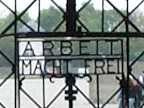 |
 |
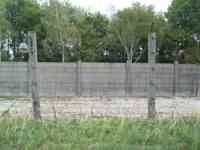 |
| Gate. Arbeit macht frei means "Work makes you free." |
Trench. The original trench did not end as this reconstruction does. The bottom was marshy. |
Fence. The fence was electrified. The barbed wire on the ground is a lot nastier than it appears in the picture. Dogs were in the corridor between the fence and the wall. |
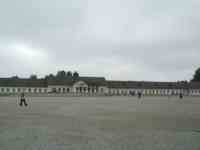 |
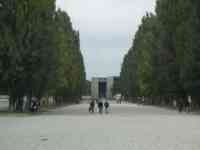 |
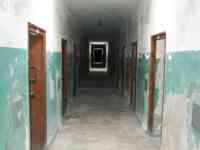 |
| Yard. Prisoners had to stand for roll call in the cold in flimsy clothing an hour each day, more on occasion. |
Road. Perspective foreshortens the camp road. It was originally lined with dozens of barracks. |
Cells for special prisoners. Favored prisoners got these better accommodations. |
Barracks
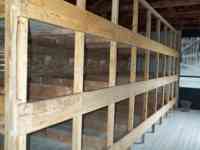 |
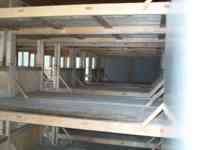 |
 |
| First-stage bunks. In the first years of the camp, each prisoner had a separate bunk with a straw mattress. |
Second-stage bunks. Later, bunks were not separate. |
Third-stage bunks. At the end, prisoners were jammed together. |
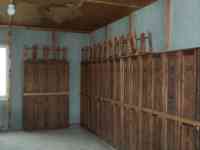 |
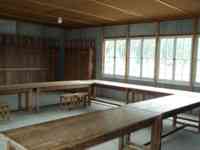 |
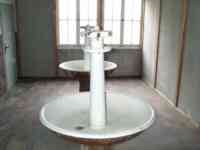 |
| Lockers. |
Tables. |
Sinks. |
Crematoria
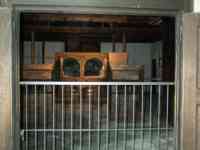 |
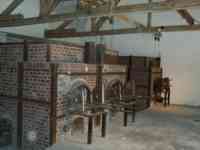 |
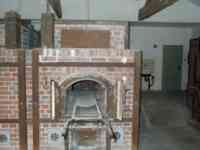 |
| First crematorium. |
Second crematorium. There were four chambers. One is offscreen. |
Crematorium chamber. |
Gas Chamber
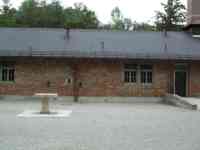 |
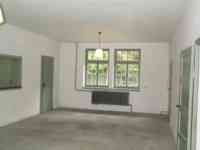 |
| Exterior. The chutes were for the insertion of poison. |
Anteroom for disrobing. |
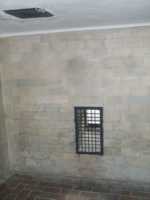 |
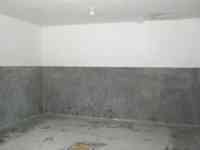 |
| Gas chamber. |
Storage space for bodies. |
Memorials
Graves
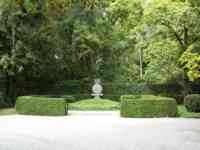 |
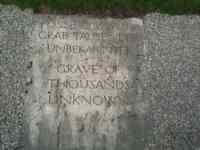 |
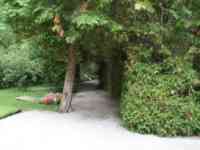 |
| Grave. Ashes found after camp liberation were buried here. |
Grave marker. "Grave of Thousands Unknown." |
Path. This path leads to more graves. |
Memorial of the International Prisoners Committee
Former prisoners selected this memorial. The sculpture is by former prisoner
Nandor Glid. The memorial has several components and is too large to be shown
in one photograph.
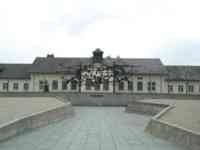 |
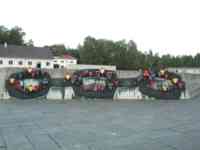 |
 |
| Path. The path starts straight (outside of picture) and becomes crooked, as the camp started lawfully and became unlawful. |
Links. Prisoners had to wear colored triangles indicating the cause of their imprisonment. These triangles are linked to show prisoners' solidarity. |
Some emaciated prisoners committed suicide on the fence. |
Parts of the memorial not shown are grassy areas representing the camp border
or gravel areas representing the yard.
Religious Memorials
Like the memorial of the International Prisoners Committee, the religious
memorials are gargantuan.
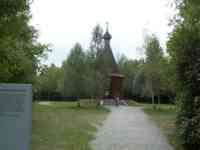 |
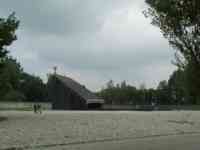 |
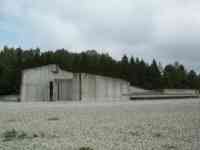 |
| Russian Orthodox Chapel. |
Jewish Memorial. |
Protestant Church of Reconciliation. |
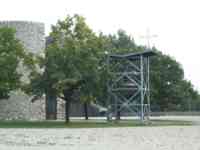 |
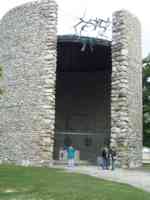 |
| Part of the Catholic memorial. |
Catholic "Todesangst Christi Kapelle." |
Other Memorials
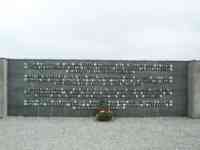 |
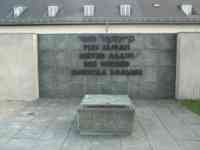 |
 |
| Memorial wall. "May the example of those who were exterminated here between 1933-1945 because they resisted Nazism help to unite the living for the defence of peace and freedom and in respect for their fellow men." |
Never Again. Ashes of the unknown concentration camp prisoner. |
Military. All of Dachau Concentration Camp is now a memorial. Learning about this history is a part of German military training. |
© Copyright 2003 by
Eric Postpischil.




















